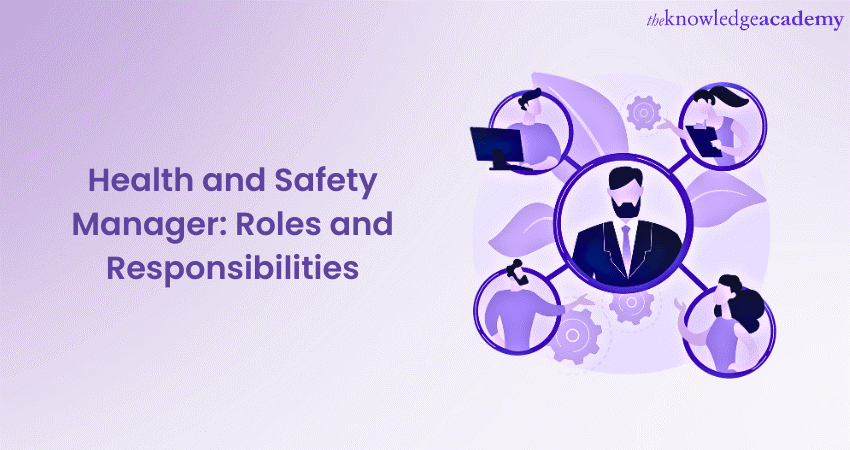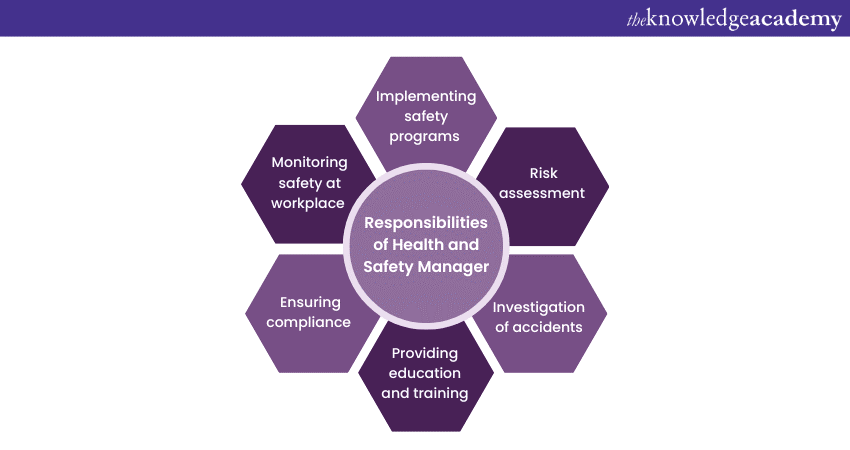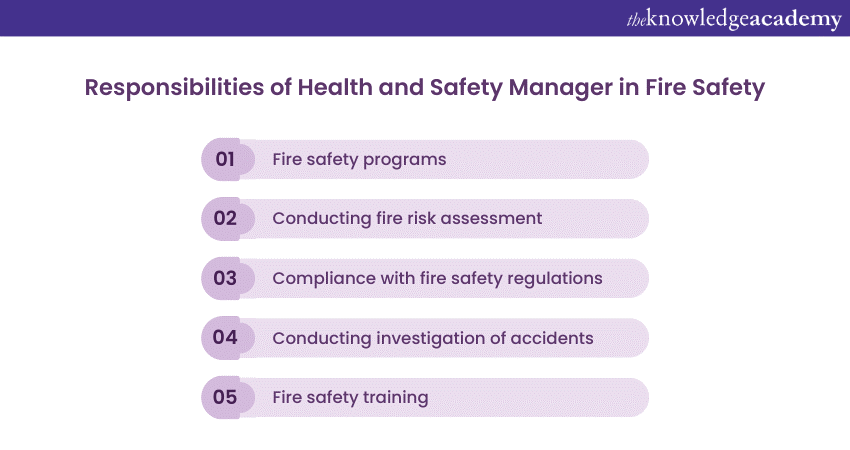We may not have the course you’re looking for. If you enquire or give us a call on 01344203999 and speak to our training experts, we may still be able to help with your training requirements.
Training Outcomes Within Your Budget!
We ensure quality, budget-alignment, and timely delivery by our expert instructors.

As workplace awareness regarding safety and health continues to grow, the role of Health and Safety Managers becomes increasingly significant. These professionals are instrumental in creating and maintaining safe and healthy work environments for employees.
According to Health and Safety at Work report, in the UK alone, 123 workers died in workplace-related accidents and 61,713 non-fatal injuries were reported in 2021/22. This shows the importance of health and safety at work. This blog post will detail the responsibilities of a Health and Safety Manager and also understand their purpose and industry-specific responsibilities.
Table of Contents
1) Who is Health and Safety Manager?
2) Purpose of Health and Safety Manager
3) Responsibilities of a Health and Safety Manager
a) Developing and implementing safety programs
b) Conducting risk assessments
c) Ensuring regulatory compliance
4) Responsibilities in the Construction industry
5) Responsibilities in Oil and Gas industry
6) Responsibilities in Environmental Management
7) Responsibilities in Fire Safety
8) Responsibilities in Managing Stress at Work
9) Required skills and qualifications
10) Conclusion
Who is a Health and Safety Manager?
A Health and Safety Manager is an individual who possesses specialised knowledge and expertise in the field of occupational health and safety. They are responsible for designing, managing, and implementing safety programs and policies within an organisation. They work in various industries, including manufacturing, construction, healthcare, oil and gas, and many others.
They are instrumental in ensuring compliance with local and federal regulations related to workplace safety. They stay up-to-date with industry standards and best practices to address potential hazards and risks effectively. By taking a proactive approach, they work towards preventing workplace accidents, illnesses, and injuries.
They are key advisors to top-level management, providing recommendations and guidance on safety-related matters. They collaborate with various departments to establish and enforce safety protocols, conduct regular inspections, and assess risks. Additionally, they may develop and deliver training programs to educate employees on safety procedures and emergency preparedness.
A Health and Safety Manager must understand the regulations, industry-specific hazards, and risk management principles. They continuously monitor and evaluate the effectiveness of safety programs, analyse incident reports, and implement corrective measures as necessary.
Learn how to implement effective health and safety at the workplace and enhance your career in occupational health and safety with NEBOSH National General Certificate In Occupational Health And Safety training course.
Purpose of Health and Safety Manager
A Health and Safety Manager's responsibilities are to safeguard workers' well-being and create a safe and healthy work environment, actively addressing potential hazards and promoting safe practices. They contribute to reducing workplace injuries, illnesses, and the associated costs.
They also serve as advocates for workers' health and safety and provide guidance, support, and training to employees. By fostering a culture of safety, Health and Safety Managers contribute to increased productivity, employee satisfaction, and organisational success.
They also serve the purpose of getting legal compliance. They stay informed about local, state, and federal occupational health and safety regulations, ensuring that the organisation meets or exceeds the required standards. Compliance protects employees and safeguards the organisation from potential legal consequences and reputational damage.
General Roles and Responsibilities of Health and Safety Manager
Health and Safety Managers are primarily responsible for establishing a secure and healthy work environment, mitigating risks, and safeguarding employee well-being.

Developing and implementing safety programs
Health and Safety Managers are responsible for designing and implementing comprehensive safety programs tailored to the organisation's specific needs. This involves thoroughly assessing potential hazards and risks within the workplace. They develop safety policies, procedures, and protocols that align with industry standards and legal requirements. These programs outline guidelines for safe work practices, emergency response plans, and the use of personal protective equipment (PPE).
Conducting risk assessments
Health and Safety Managers perform regular inspections to identify hazards in the workplace. They evaluate work processes, machinery, equipment, and environmental factors that could pose risks to employees' health and safety. By identifying these hazards; they can develop and enforce appropriate control measures to mitigate them. This may involve modifying work procedures, improving engineering controls, or providing additional employee training.

Ensuring regulatory compliance
Health and Safety Managers stay up-to-date with relevant health and safety regulations and ensure the organisation's compliance. They familiarise themselves with local, state, and federal regulations that govern workplace safety and ensure that the organisation meets or exceeds these requirements. They review and update safety policies and procedures to align with regulatory changes. They also facilitate inspections and audits to ensure adherence to safety standards and promptly address non-compliance issues.
Providing training and education
Health and Safety Managers develop and deliver training programs to educate employees about safety practices, emergency protocols, and the proper use of protective gear. They conduct training sessions and workshops to raise awareness about potential hazards, preventive measures, and safe work practices.
Investigating incidents and accidents
In the unfortunate event of workplace incidents or accidents, Health and Safety Managers lead investigations to determine the root causes and implement corrective actions. They analyse incident reports, gather evidence, conduct interviews with involved parties, and collaborate with relevant stakeholders to assess what factors led to the incident. Based on their findings, they develop strategies to prevent the repeat of similar incidents. This may involve implementing additional safety measures, training, or improving existing protocols.
Gain the skills you need to investigate incidents effectively with NEBOSH HSE Introduction To Incident Investigation Training course.
Monitoring and reporting
Health and Safety Managers establish systems for tracking and monitoring safety performance indicators. They collect and analyse data related to incidents, accidents, near misses, and safety inspections. They generate reports highlighting trends, identify improvement areas, and provide recommendations to enhance safety measures. These reports are shared with management and relevant departments to ensure continuous improvement and a proactive approach to workplace safety.
Collaboration and communication
Health and Safety Managers work closely with various departments, management, and employees to foster a collaborative approach to health and safety. They communicate safety requirements, policies, and procedures to employees, ensuring their understanding and compliance. They also guide and support supervisors and managers, assisting them in implementing safety practices within their respective areas. They act as a resource for employees, addressing safety concerns, answering questions, and promoting a positive safety culture.
Responsibilities in the Construction industry
Working in the construction industry usually comes with a lot of hazards and risks. Some of the common hazards in a construction environment are:
a) Falls and trips
b) Injury by machine failure
c) Falling debris or materials
d) Electrical accidents
e) Manual handling of heavy objects
Health and Safety Manager responsibilities play a crucial role in mitigating risks, preventing accidents, and protecting workers' well-being in the construction industry. Here are the key responsibilities they have when managing safety in construction:
a) Developing and implementing safety programs tailored to construction hazards.
b) Conducting site inspections and risk assessments to identify potential hazards.
c) Ensuring compliance with construction safety regulations and standards.
d) Providing training and education on safety practices and equipment usage.
e) Investigating incidents and accidents to determine causes and prevent future occurrences.
f) Monitoring and enforcing safety measures on construction sites.
g) Collaborating with contractors, subcontractors, and stakeholders to promote a safety culture.
Gain in-depth knowledge of health and safety at work and get trained in international frameworks with NEBOSH International General Certificate In Occupational Health And Safety Training course.
Responsibilities in Oil and Gas industry
Working in the oil and gas industry domain presents significant hazards and risks that require diligent safety management. Some common hazards in this industry are given in the image.
In this context, Health and Safety Managers play a vital role in mitigating risks, preventing accidents, and ensuring the well-being of workers. In the oil and gas industry, they are pivotal in minimising risks, preventing accidents, and protecting the well-being of workers.
Their expertise and proactive approach create a safer working environment, enhance productivity, and reduce incidents in challenging and high-risk oil and gas operations. Here are their key responsibilities in managing safety in the oil and gas industry:
a) Developing and implementing tailored safety programs specific to the hazards and risks present in oil and gas operations.
b) Regularly conduct inspections of oil and gas facilities to identify potential hazards and evaluate risks.
c) Ensuring compliance with safety regulations and standards and working closely with operators and contractors to maintain adherence to these regulations.
d) Providing training programs to educate oil and gas workers on safety practices, hazard recognition, and emergency response protocols.
e) Investigating incidents and accidents.
f) Monitoring and enforcing safety measures to ensure compliance with safety protocols and regulations.
g) Collaborating with operators, contractors, and stakeholders to promote a strong safety culture within the oil and gas industry.
Responsibilities in Environmental Management
Health and Safety Manager responsibilities in environmental management are instrumental in promoting sustainable practices, minimising environmental impacts, and ensuring regulatory compliance. Their expertise and proactive approach contribute to creating a greener workplace and driving the organisation toward a more sustainable future. Here are their key responsibilities in managing safety in environmental management.
a) Developing and implementing environmental management programs
b) Conducting regular environmental audits and assessments to identify potential environmental risks and areas for improvement.
c) Ensuring compliance with environmental regulations and ensuring compliance with regulations pertaining to air quality, water management, hazardous materials handling, and waste disposal.
d) Providing environmental training to educate employees on environmental awareness and sustainable practices.
e) Implementing standards like ISO 14001 for environmental management within the organisation.
f) Promote environmental sustainability.
g) Monitoring and reporting environmental performance.
Responsibilities in Fire Safety
Health and Safety Manager responsibilities in fire safety are instrumental in minimising fire risks, protecting lives, and preserving property. Their expertise and proactive approach contribute to creating a fire-safe environment, ensuring compliance with fire safety regulations, and promoting a fire-safety-conscious workplace.

Here are their key responsibilities in fire safety:
a) Developing and implementing comprehensive fire safety programs specific to the needs and risks of the workplace.
b) Conducting regular fire risk assessments to identify potential fire hazards and evaluate the effectiveness of existing fire safety measures.
c) Ensuring compliance with fire safety regulations and staying updated with fire safety regulations and standards applicable to their industry and location.
d) Providing fire safety training and education to deliver fire safety training programs to educate employees on fire prevention, emergency response, and evacuation procedures.
e) Overseeing the implementation of fire safety measures and systems in the workplace.
f) Encouraging fire safety in the organisation by collaborating with internal and external stakeholders.
g) Conducting fire incident investigations in the event of an incident and lead investigations to determine the causes and prevent future occurrences.
Gain the skills you need to prevent accidents and injuries with NEBOSH HSE Certificate In Process Safety Management training course.
Responsibilities in Managing Stress at Work
Managing workplace stress is essential for promoting employee well-being, productivity, and overall organisational success. They play a crucial role in identifying and addressing stress-related factors in the workplace. Here are their key Health and Manager responsibilities in managing stress at work:
a) Identifying stressors within the workplace.
b) Conduct stress risk assessments to evaluate the level of stress employees may experience and the potential harm it can cause.
c) Developing stress management programs to address the identified stressor.
d) Providing training, education, sessions, and workshops to educate employees on stress management techniques and coping strategies.
e) Promoting work-life balance within the organisation.
f) Enhancing communication and support systems to foster open dialogue about stress-related concerns.
g) Monitoring and evaluating stress management initiatives.
Required skills and qualifications
A Health and Safety Manager should have the following skills and qualifications:
a) In-depth knowledge of health and safety regulations.
b) Risk assessment and management expertise.
c) Strong communication and interpersonal skills.
d) Leadership and management abilities.
e) Analytical and problem-solving skills.
f) Training and presentation skills.
g) Relevant qualifications and certifications, such as a qualification in occupational health and safety certifications like NEBOSH.
h) Industry knowledge and experience.
i) Continuous learning and professional development.
NEBOSH also offers industry-specific certifications like Health and Safety Management for Construction (UK/International), International Technical Certificate in Oil and Gas Operational Safety and others. Getting a specialised certificate is recommended over general certifications if you are specifically interested in a niche domain.
Conclusion
Health and Safety Managers have a lot of responsibilities and work towards maintaining a safe work environment, preventing accidents, and protecting employee well-being. Their responsibilities include risk assessment, compliance, training, incident investigation, and stakeholder collaboration. Health and Safety Managers are instrumental in promoting a positive safety culture and ensuring organisational success through workplace safety.
Become an expert in workplace safety and health with our comprehensive NEBOSH courses.
Frequently Asked Questions
Upcoming Health & Safety Resources Batches & Dates
Date
 IOSH Managing Safely Course
IOSH Managing Safely Course
Mon 2nd Sep 2024
Mon 18th Nov 2024
Mon 10th Feb 2025
Mon 28th Apr 2025
Mon 16th Jun 2025
Mon 28th Jul 2025
Mon 1st Sep 2025
Mon 3rd Nov 2025







 Top Rated Course
Top Rated Course


 If you wish to make any changes to your course, please
If you wish to make any changes to your course, please


